Sales Order Document
Basic Data (1st page)
On 1. Basic data that create a document header are stated on the 1stpage of a Sales Order document. The heading data (first three rows) are also displayed on the other pages of the document.
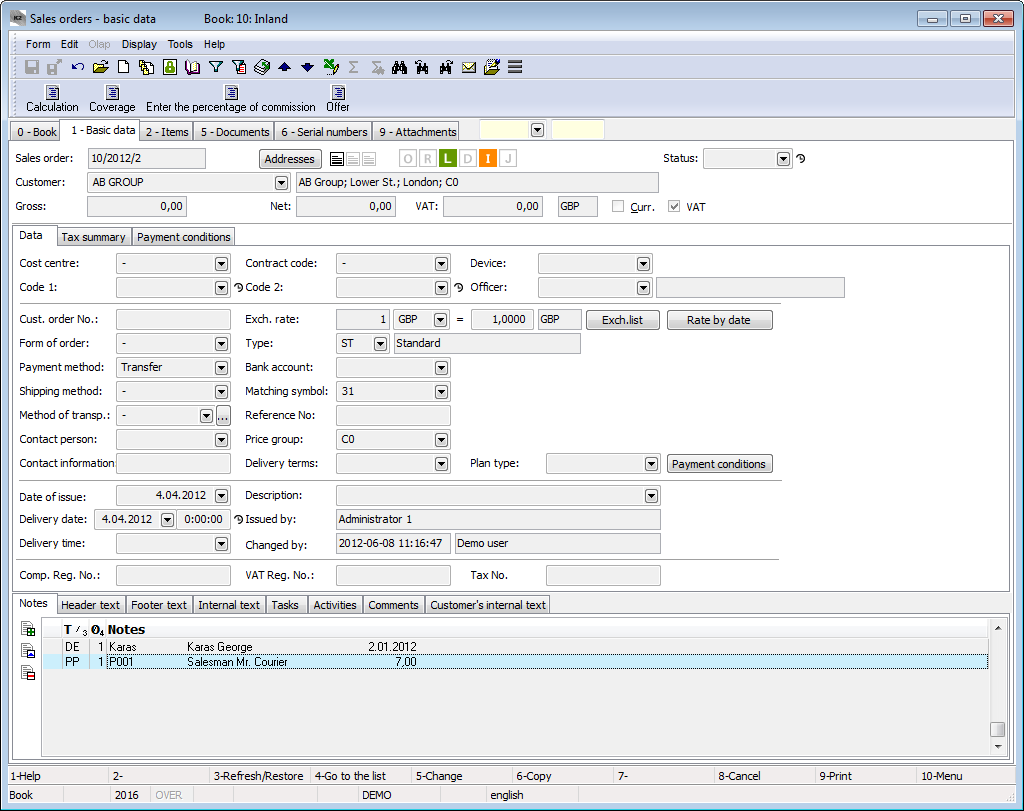
Picture: Sales Order - 1stpage Page chapter).
Field description:
Contract |
The number and the business year of a Sales Order. |
Addresses |
This button activates the form for entering the addressee. The form can also be activated by the Ctrl+F4 key combination. Closer description is in the chap. Addressee. |
Status |
The field for selecting from a code list that enables filtering of documents according to the selected status. |
Customer |
Basic data about a customer – abbreviation, name, country, city, price group. A structure of these information is set in the Client Parameters. |
Prices |
The data about prices - the gross price, the net price, VAT and the currency code items. |
Currency |
The option is automatically checked according to the entered currency on a document. |
VAT |
The option indicates that the Sales Order is issued withVAT. VAT. |
Substitute Payment Mode |
The option defines whether a Sales Order is in the substitute payment mode. |
It is possible to assign random types and kinds of notes to Sales Orders; it is also possible to use the Header Text or the Footer text. Further work description with The notes is listed in the Basic Code Lists and Supporting Modules K2 – Notes chapter The Internal Text tab serves for entering a text of any length to a Sales Order. If a text is entered, the "*" sign will be appear on the tab. Customer Internal Text tab serves to display the customer internal text only. There are also the Tasks and Activities tabs. A closer description of work with the folders is stated in the Tasks - Document Folder and the Activities - Document Folder chapters.
Payment conditions can be displayed on the Payment Conditions tab and they can be edited with the same button.
Basic data of the header are divided into two tabs.
The Data tab contains basic information of the document header.
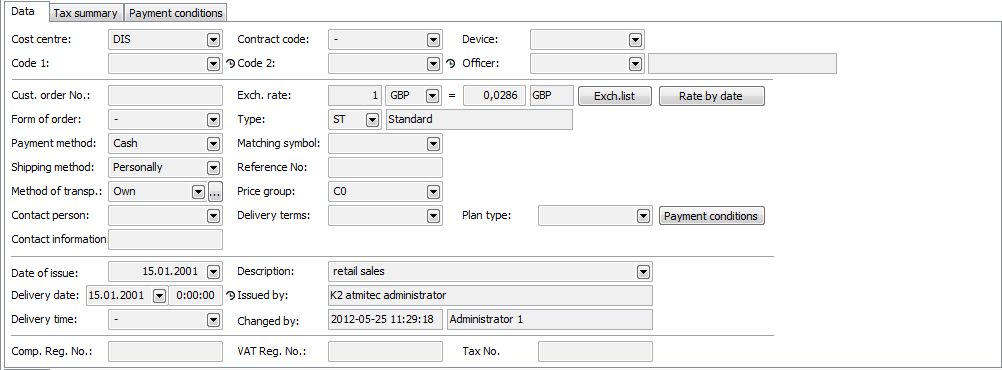
Picture: Data - Sales order (page 1)
Field description:
Cost centre |
The cost centre that has issued the Sales Order. |
Contract Code |
Contract code. |
Device |
A reference to the Device book. It is copied from a Sales Order into the subordinate documents. |
Code 1, Code 2, Officer |
The fields enable user identification, and eventually a link to the Officers book. Closer description is in the chap. For the further description see the Basic Code Lists - Code 1, Code 2, Officer chapter. |
Cust. Order. No. |
The field for typing the Order No. under which a Sales Order has been issued. |
Form of order |
In which way the customer ordered the goods. |
Payment Method |
The method of payment for the withdrawn goods - in cash, by bank transfer, cash on delivery etc. It is the user's code list. By ticking the Cash on delivery option on the 1st page of the record, it is possible to determine that the selected payment method is "cash on delivery". This flag is used to determine the Cash on delivery in the Consignments module. By checking the Cash on Delivery option on the 1st page of the record, it is possible to determine that the selected payment method is "cash on delivery". Based on the credit settings, cash payments do not have to enter the credit limits (see the 'Credits' section). Note: The payment method can influence the Invoice rounding. For the further description, see the Rounding of Domestic Invoices Depending on Payment Method methodology. |
Method of transport |
Method of transport of goods. If a record of the method of transport has the Shipping Method Assigned option active, you can enter only the records that are assigned to the particular method of transport into the Shipping Method field (a closer description at the Shipping Method field). Button |
Shipping Method |
Shipping method of goods. The records of shipping methods may be assigned to the records of Method of Transport. If a record of the method of transport has the Shipping Method Assigned option active, only the shipping methods that are assigned to the particular method of transport will be offered to select from into the document. The Service Code field is used for consignment communication with the 'Balikobot' company. |
Contact Person |
A person who has agreed the deal on the part of the customer. The link to the Contact Persons book. After displaying the book of Contact Persons (e.g. With F12), a filter of only those contact persons who belong to the specific partner of the selected customer will appear. If the customer is not selected during the choosing of a contact person yet, a list of all contact persons will appear. If the user enters a character (characters) into the Contact Person field and presses the Ctrl + Spacebar shortcut in the Contact Person field, only the contact persons from the whole book which start with the entered character will be offered (i.e. without a link to the selected partner of the customer) . |
Contact Information |
The field can remain empty or you can write in your own random text. |
Exchange Rate |
The currency for which the sales order has been issued. There is also an exchange rate for the recalculation between the basic currency and the currency of the Sales Order in this field. |
Exchange List |
This button opens the Exchange List where you can select from the defined exchange rates. Exchange rates are defined in the Currency code list. |
Exchange Rate According to Date |
This button fills the exch. rate from the exchange list valid on the sales order date of issue. It can be run in the Change mode only. |
Type |
The type of tax. It is filled into the document from the Suppl./Cust.card. (if it is entered here) or from the Book of sale. |
Bank account |
The account that is set on a Customer card will be pre-filled in. |
Matching Symbol |
Data about a matching symbol. The symbol is further used in Accounting. |
Variable Symbol |
The reference number of a Sales Order. It can be created automatically according to the setting in the Books of Sale. |
Specific Symbol |
A specific symbol. |
Price Group |
A price group of a Sales order. This price group is automatically added according to the price group defined in the Suppl./Cust. card and is further copied into the Sales Order items. |
Delivery Terms |
The records of Delivery Terms. It is pre-filled with the data from a Customer card. |
Plan Type |
Selection from the Plan Type code list that serves to distinguish the planning and actual documents. A plan type that is defined on the 1st page of the Book of Purchase/Sale in the Plan Type field is entered into new documents by default (see the Basic Code Lists and Supported K2 Modules - Plan Type chapter). |
Comp. Reg. No. |
Comp. Reg. No. of a customer. If it is not defined here, the Comp. Reg. No. from the Customer card is applied. |
VAT Reg. No. |
VAT Reg. No. of a customer. If it is not defined here, the VAT Reg. No. from the Customer card is applied. |
Tax No. |
Tax number of a customer. If it is not entered, the tax No. from the Customer card is applied. |
Date of Issue |
The date of issue of a Sales Order. |
Requested delivery |
The date by which article must be delivered. If filled in, it is transferred to the field of newly inserted items of the same name. After changing the value, this term can be transferred to the existing items of the document. |
Confirmed at |
The date on which we confirmed the delivery of article to the customer. It is automatically filled with the Requested Delivery Date if the date is not entered or is the same as the Requested Delivery Date. If filled in, it is transferred to the field of newly inserted items of the same name. After changing the value, this term can be transferred to the existing items of the document. It can be entered by the user only in universal forms. |
Dispatch |
The date when the articles are to be sent. It is not filled in automatically. If filled in, it is transferred to the field of newly inserted items of the same name. After changing the value, this term can be transferred to the existing items of the document. It can be entered by the user only in universal forms. |
Delivery Time |
The period within which article must be delivered. |
Description |
To distinguish individual sales orders in the book, a description can be entered or a text from the code list can be selected. |
Created |
The name of the employee who has issued the sales order. |
Changed By |
The date and name of the employee who made the last change of the sales order. |
Payment Conditions |
The button serves to set the payment conditions for the appropriate sales order. The detailed description is stated in the Purchase and Sale Shared Elements - Payment conditions chapter. |
There is a table of price recapitulation in the Tax Summary tab.

Picture: Tax Summary - Sales Order (1st page)
Items (2nd Page)
On 2. nd page of a Sales Order are classified the items that are the subject of Sale. We insert a new item in the Change or in the New Record with the Ins key, after which the Sales Item form is displayed. Display the same form by pressing Enter on an item of a Sales Order.

Picture: Sales Orders - 2nd Page
In the heading of the document, you can display the data about the planned and the actual profit and margin of a document. See further description in the Profit, Margin and Stock Price chapter.
To mark records, we can use the buttons ![]() in the Change,
in the Change, ![]() and
and ![]() described in the chapter Marking records.
described in the chapter Marking records.
Values in the document items, including discounts, can be adjusted in bulk with the Bulk Change of Items button in the Change mode. For further description of this function, see the Bulk Edit Document Items and Purchase and Sale Items chapters.
The RV Items button serves for displaying a Routing Variant of an indicated item of a product or of a semi-finished product.
In the lower part of the 2nd page of a Sales Order are the buttons related to Advances Received. The amounts are stated in the currency of a Sales Order.
Description of Selected Fields:
New Advance to Sales Order |
The button for creating a new Advance Received with pre-filled data from a Sales Order. |
New Advance to Sales Order in % |
The button for creating a new Advance Received with pre-filled data from a Sales Order. Enter amount of the Advance in %. |
Advances to Sales Order |
The button for displaying the Advances to a Sales Order. |
Advances to Customer |
The button for displaying the Advances to a Customer. |
Deducted from Adv. to Sales Order |
The amount of Advances to a Sales Order that has already been deducted on an Invoice. |
Deducted from Adv. to Customer |
Amount of Advances to a Customer that has already been deducted on an Invoice. |
Remains to Be Deducted from Adv. to Sales Order |
Amount of the paid Advances to a Sales Order that has not been deducted on an Invoice yet. |
Remains to Be Deducted from Adv. to Customer |
Amount of the paid Advances to a Customer that has not been deducted on an Invoice yet. |
Further description of issuing an Advance Received is stated in the Process of Receiving an Advance From a Customer chapter.
In the heading of a Sales Order, bitmaps that inform about the existence of Advances may appear on the 1st and the 2nd page:
 they inform the user about the existence of a paid, non-deducted Advance to a Sales Order,
they inform the user about the existence of a paid, non-deducted Advance to a Sales Order,  inform the user about the existence of an unpaid Advance to a Sales Order.
inform the user about the existence of an unpaid Advance to a Sales Order.
Note: If you indicate a selected item by the light indicator and press the Ctrl+F8 keys, a form for creating a new Service Sheet will be displayed. It is necessary to set up the Complaint / Services module for this functionality.
The discount coupon is applied in the Change mode by means of the Ctrl + F7 keys. The Coupon Application form, where the code of coupon is entered, is displayed. Only one discount coupon per document may be applied. The item (the Article card according to the value in the Article card field on the 1st page of the appropriate coupon) will be inserted after pressing OK.

Picture: The Coupon Application form
If the conditions for applying a coupon are met, the statistics on the third page of the discount coupon will be updated, a record will be added into evaluation items on the third page, and if the conditions to change the status to Applied are met, this change will also be executed after saving an item on the Sales Order. (e.g. if the limit of coupon application is met).
Conditions for Coupon Application
- the discount coupon is in the active state,
- the condition for the minimum amount is satisfied,
- there is an article contained in the product key (if entered) on the Sales Order item,
- the customer is included in the customer key (if entered),
- the document currency is in the currency of the discount coupon
- no other coupon has been applied to the document yet,
- the Sales Order has been issued in the book of Sale that is defined
- There is the Unique customer option checked on the discount coupon and simultaneously it is the first coupon application for the appropriate customer.
- The coupon validity is higher than the current date.
- A coupon may be applied to a document with positive amount only
If some conditions are violated, an error message will appear.
Documents (5th Page)
On 5 page of a Sales Order, there is an overview of all documents that are linked to the Sales Order on the You can move between the individual documents by pressing Ctrl and the initial letter of the document simultaneously. The selected document can be also displayed by the Ctrl+Enter key combination.
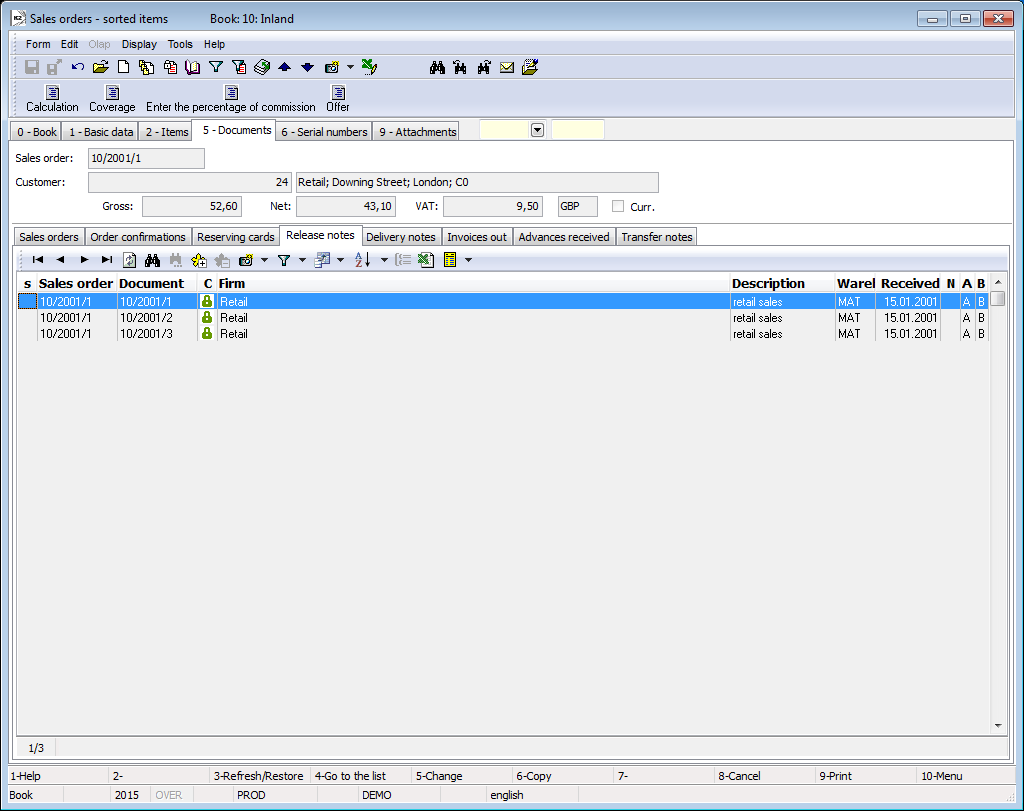
Picture: Sales Orders - 5. page with the open Release Notes tab
External documents (9th page)
On 9. page tab of sales order is possible same as in other IS K2 documents, insert documents and assign links to documents. Further work description with This page is listed in the chapter Basic Code Lists and Supporting Modules K2 – 9th Page.)
Internal sales orders - internal reservation on production
An Internal Sales Order is a document that forms an internal requirement for the production of a product or a semi-finished product. We create internal sales orders in the Books of Sale that has the Internal Sales Orders option checked. The value that defines this is an Internal Sales Order item is stored in the Sale item.
An internal sales order item with a reservation list and without a job card with Execution creates a production requirement in Coverage. These are the types of records:
- Int. reservation - req. (Internal reservation for production - request) - unconfirmed reservation list
- Int. Reservation - Confirm. (Internal reservation for production - confirmed) - confirmed reservation list
The value of these records in Coverage is positive and is added to the total coverage status. It represents future production - receipt to the warehouse.
The amount of internal reservations on products can be tracked in the Articles book using the Internal reservation column.
Functions for Sales Orders
Alt+F6 |
Release from a handling unit. The function serves to insert all items from the selected handling unit into the document (page 2 in the Change mode). A Release Note will be automatically created for items. If a warehouse and a zone are pre-filled in the Book of Sale, the Release Note is preferentially created for this warehouse and zone. |
Ctrl+F8 |
Gantt Production Status chart is displayed - a chart showing the status of production. From page 0: all Sales Order items are loaded. From page 2 in the Browse mode: the current marked item or items indicated with an asterisk are loaded. A detailed description of the chart is stated in the Gantt Production Status chapter. |
Ctrl+Shift+F6 |
For the current marked item, it opens the form of Wizard of the stock record and allows to enter the selected combination manually (contract code + batch + location) to the document item directly from the rows of document items. (2nd page, in the Change mode). |
Ctrl+Shift+F8 |
This creates a new Service Sheet for the currently marked item (page 2 in the Browse mode). It can be run from all Sales documents. |
Ctrl+Shift+F8 |
It opens the form Work in Progress by Workplaces (page 0, for current or marked Sales Orders). The function is available in the new user interface only. A closer description is provided in the chapter Sales Orders - Work in Progress by Workplaces. |
Cancel Sales Orders (F8)
If a Sales Order has already been saved (the number has been assigned to it), it cannot be deleted in any way. You can cancel it by pressing the F8 key. A cancelled Sales Order remains in the database with its content remaining undisturbed; it only has the flag of cancellation. Therefore, it is always possible to find out what was its content. It is not possible to change a cancelled Sales Order any more as in the case of confirmation.
If a Sales Order contains some confirmed subordinate documents, it cannot be cancelled. If a Sales Order contains some unconfirmed subordinate documents, the program will ask whether the subordinate documents should be cancelled as well. If the user has the right, then all documents will be cancelled at the same time.
Sales Orders - Work in Progress by Workplaces
The function shows the status of work in progress of individual Sales Order items by workplaces. The form of the function may be activated with the Ctrl+Shift+F8 keys over the list of Sales Orders (for current or asterisk-indicated records). The function is available in the new universal forms only.
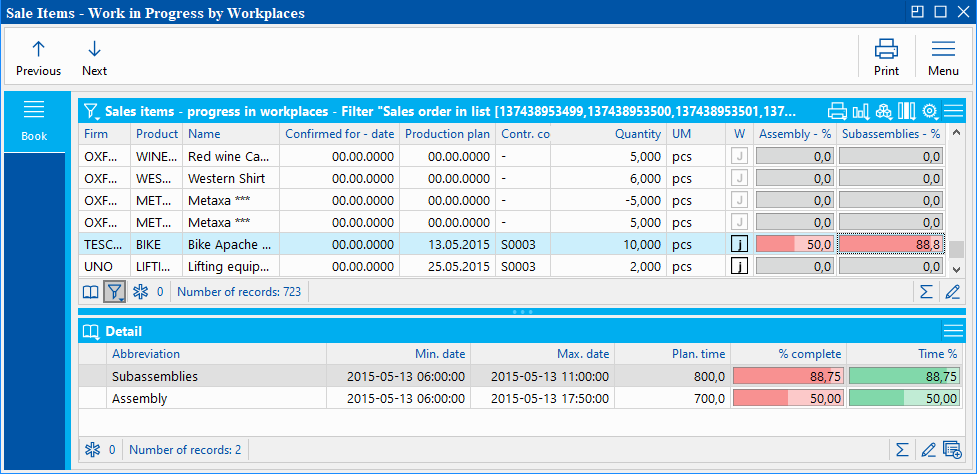
Picture: Sale Items - Work in Progress by Workplaces
Sale Items - Work in Progress by Workplaces
An overview of items of selected Sales Orders is displayed in the upper part of the form, the status of work in progress (the fulfillment percentage) at individual existing workplaces is provided in the columns. Apart from the value of the fulfillment percentage, the item status with regard to keeping up to the implementation dates is indicated by colours. Clicking on a specific unit of the table will show detailed information about the status.
|
Light red indicates the status where the production is in delay, which means that the current date is equal to or higher than the requested deadline from the Job Cards. Dark red indicates the actual percentage completion. |
|
Orange expresses the status where the production may be in delay. This means that the production has not begun yet, although the current date is higher than the requested date of beginning from the Job Cards. At the same time, the current date is not higher than or equal to the requested deadline. The production may still be finished in time (e.g. by adding a shift, increasing the number of resources, etc.). |
|
Light grey and the value 0 marks the workplace that does not participate in the production of the item. |
|
Dark grey and the value 100 marks a completed task - regardless of it being finished in time or not. |
|
White and the value 0 indicates the status where the production has not begun yet, while the current date is lower than the requested date of beginning. |
|
Light green means that the production is running according to the plan. It has already been started and the current date is within the interval of the requested date of beginning and the deadline. Dark green indicates the actual percentage completion. |
Detail
An overview of workplaces with additional information is displayed in the lower part of the currently indicated Sales Order item.
Min. Date, Max. Date |
The minimum date of start and the maximum deadline from the Job Cards of the given workplace. |
Complete % |
The percentage complete identical with the data in the upper table of a specific workplace. |
Time % |
The percentage of time spent on completing the task. |
Reports - Sales Orders
Contract
Process No.: ZAK014 |
Iden. Report no.: SZAK002 |
File: ZAK_DOK01='AM' |
Report description: A Sales Order of a customer. |
||
Address in the tree: [Sale / Processing of Sales Orders] [Sales Orders] [Sale / Processing of Sales Orders] [Sales Orders] [Print Documents - Lists] |
||
Report parameters:
Assignment - No Yes - displays document posting (data from the 3rd page of the document). |
BarCode - No Yes - a bar code is displayed. |
Batch - No Yes - batches for an item are displayed. |
BatchAttr - 0 0 - nothing is displayed; 1 - batch parameters are displayed; 2 - required batch parameters are displayed. |
BusinessRegister - 1 Information about the Business Register from the Own Company Settings is displayed. 0 - does not display information about the Business Register, 1 - displays a maximum of two lines of text about the Business Register, 2 - displays a maximum of four lines of text about the Business Register. |
CataloguePrice - Yes Yes - catalogue prices for items are displayed. |
CodeAndCentre - 0 The cost centre and the code are displayed according to the settings: value 0 - nowhere, 1 - in the header, 2 - in items, 3 - in both places. |
CodeOfCurrency - No Yes - a code of currency is displayed (e.g. USD). No - the sign of currency is displayed (e.g. $). |
CombineOrigItem - Yes Yes - merges the items with the same "OrigItemF" (if it is not different in price and other attributes). |
Contacts - 1;Addr;TaxNum;Tel1;Fax1;Email1;WWW The parameter has a total of 10 positions, the first three are fixed: 1. position: a user whose contacts from the user card (telephone, mobile, fax, email) are printed. Options: 0 - no user contacts, 1 - the user who has issued the doc., 2 - the currently logged in user, who prints the documents. 2. position: "Addr" - if it is specified, a company address is displayed. 3. position: "TaxNum" - if specified, the ID-No. and VAT Reg. No. are displayed. 4th - 10. position: listed types of electronic addresses of the own company (i.e. there may be up to 7 types). Example: (Contacts - 1;Addr;;TEL1;FAX1;WWW1): The Company Address will be displayed, behind which are the contacts from the user card, (tax numbers are skipped by an empty string on the 3rd place), then there are electronic addresses with Tel1 type, Fax1, WWW1. Note: If one piece of data is suppressed, there is no vacancy. Nevertheless, the default order in the report is always as follows: address, Tax No., user contacts, entered electronic addresses of own company. |
DefaultExport - No This is described along with other export parameters in the Report Parameters for Bulk Sending via E-mail chapter. |
Description - No Yes - information from the Description field from the 1st page of the document is displayed. |
DescriptionFromItem - Yes Yes - a supplement that is entered into the Description field in a document item is displayed. |
Discount - Yes Yes - a discount entered in item is displayed. |
DraftLabel - Yes Yes - if a document is not confirmed, "DRAFT" text is displayed in the background of a report. No - "DRAFT" is not displayed. |
Export_... - various parameters The report also includes export parameters described collectively for all documents in the Report Parameters for Bulk Sending via E-mail chapter. |
Interactive - No No - an initial form to enter parameter values is displayed. |
JCKindItem - A list of kinds that are printed in a tree of Job Cards (you have to separate more kinds by a semicolon). |
JCTreeLevel - 1 0 - all the levels of Job Cards are displayed for items, 1 - without Job Cards 2,3,4... - number of levels. |
K2Info - Yes Yes - displays an informative text about the document issued by the K2 system. |
KeepEnvelopeFormat - No No - the blank space under a place for envelope window is hidden. The saved place is multiplied, if the "ShowBarCode" parameter is set on "No". Useful if the user does not use the window envelopes and does not want to fold the printed document into an envelope according to the cam line guide of a document. Yes - the place is not hidden - the line between items and the address part will always be in one third of the page. |
LangAccordToParams - No If the report has to be printed in a language that is set in the "Field Language" and "Report Language" parameters, you have to set the value of the parameter to "Yes". |
LeftEnvelopeWindow - No Yes - the address of a customer is printed on the right side (determined for sending documents by mail in abroad where a window for envelope is on the left side); No - the address of a customer is on the left side. |
LeftShift - 5 By how many mm the edge of the report is shifted to the left (sets the print on a printer). |
LogoPictureFooter - 0 Parameter adjusts the footer logo display. If the parameter is empty, the footer logo is displayed according to the parameter settings Picture in Footer in the function Administrator - Administration of Own Companies. 0 - nothing is displayed, but a place is kept vacant (for a header paper), 1 - neither picture nor free place. File name with png suffix - specific picture in the Pictures directory of the given company. |
LogoPictureHeader - Parameter adjusts the header logo display. If the parameter is empty, the header logo is displayed according to the parameter settings Picture in Header in the function Administrator - System - Administration of Own Companies. 0 - nothing is displayed, but a place is kept vacant (for a header paper), 1 - neither picture nor free place. The conditions are to set the parameter KeepEnvelopeFormat to No. File name with png suffix - specific picture in the Pictures directory of the given company. |
Notess - Enter the comment type from the document header, which is to be displayed in the report into the parameter. To display more comment types, it is necessary to separate the individual types by using the semicolon (e.g. MAIL;CMR). If multiple comments of the same type are found, all of them are displayed. |
NumberOfItem - 1 0 - no number is displayed, 1 - the number of a Sales Order item is displayed; 2 - the Purchase Order number is displayed. Always in the "#001" format. |
OneLineItem - No Yes - the document item is always displayed on 1 row. |
ProportionalFont - Yes Yes - supplements are displayed in the Verdana font type, No - CourierNew font type. |
SerialNumber - No Yes - displays the serial numbers at the items. |
Sign - @Vyst;;; The parameter contains 5 positions: 1st position determines the person whose signature should be displayed. It may be a picture named according to the Logname of the user who has issued the document (@Vyst) or who prints the document - i.e. according to the current login (@akt) or the current Logname.
The value entered in the Stamp field in Administration of Own Companies is used by default. The path and the name of the file is entered here. The path may be entered by using the alias. Instead of entering the specific file name, it is possible to use %s. The picture must always be in the xxx.png format. If it is not filled in the Administration of Own Companies, the file will be searched in the Picturesdirectory.
An example of an entered task in the Stamp field in Administration of Own Companies: via alias: k2*DEMO\Pictures\stamp.png (searches the picture in the Client's path. The file stamp.png in the Pictures directory) via %s: k2*DEMO\Razitka\%s.png (the value entered this way enables to display signed bitmaps to all users who issue documents or are currently logged in and have the file in the PNG format in the directory (in this case the user created Stamp directory).
2nd position: picture height. 3rd position: distance from the left edge. 4th position: distance of a picture from the upper edge of the given section. 5th position: picture width. Example: (Sign - @vyst;27;47;0;83) prints the signature of the user who has issued the document, height is 27 points, left indentation of 47 points, by the upper corner. The picture is 83 points wide.
If the parameter is set to 0, the stamp will not appear. |
SortBy - The field is filled with the value of the field from Sale items (e.g. C_Zbo;Zkr or CF_CeJePlM). Items on a document will be sorted according to the parameter value. Parameter is empty by default. If the value of this parameter is specified, the items are not combined even if the CombineOrigItem parameter is set to Yes. |
StateOfOrigin - No Yes - a code of tariff and a country of origin are displayed for the items. If it is filled on a batch, information from the batch are displayed; otherwise the data from the Article card are displayed. |
SupplFromArticles - 0 - Nothing is displayed, Empty value - a Business Text from an Article card is displayed. If the parameter is filled in, and if there is an existing comment type on the Article card that is identical to the parameter value, the text of this comment is displayed. If the given comment type does not exist, the entered type of supplement from the notes on the Article card will be displayed (e.g. the DB type). If both comment and supplement type are identical, the comment has priority over the supplement. |
SupplFromCustomer - DZ 0 - Nothing is displayed, Empty value - a Business Text from a Customer card is displayed. If the parameter is filled in, and if there is an existing comment type on the Customer card that is identical to the parameter value, the text of this comment is displayed. If the given comment type does not exist, the entered type of supplement from the notes on the Customer (e.g. the DZ type). If both comment and supplement type are identical, the comment has priority over the supplement. |
SupplFromItem - 0 - Nothing is displayed, Empty value - displays the entered text from the Text tab from the document item. If the parameter is filled in, and if there is an existing comment type on the document item that is identical to the parameter value, the text of this comment is displayed. If the given comment type does not exist, the entered type of supplement from the notes on the document item will be displayed (e.g. the TX type). If both comment and supplement type are identical, the comment has priority over the supplement. |
SupplFromClient - TEXT The TEXT value displays information from the General information field from an own company. Otherwise it displays supplement type from the Client parameters. |
TaxRecapitulation - Yes Yes - the tax recapitulation is displayed. |
TermsOfDelivery - Yes Yes - 'Delivery date' text is displayed next to the items, No - 'Offer is valid until:' text is displayed. |
Title - The entered value of the parameter is displayed as a report title. If the parameter is empty, the original name of the document is printed. |
TotalAmount - No Yes - information about the total amount is displayed. |
TotalItems - No Yes - information about the total number of items is displayed. |
Weight - No Yes - the weight of individual items and the total weight of a "document" are displayed. |
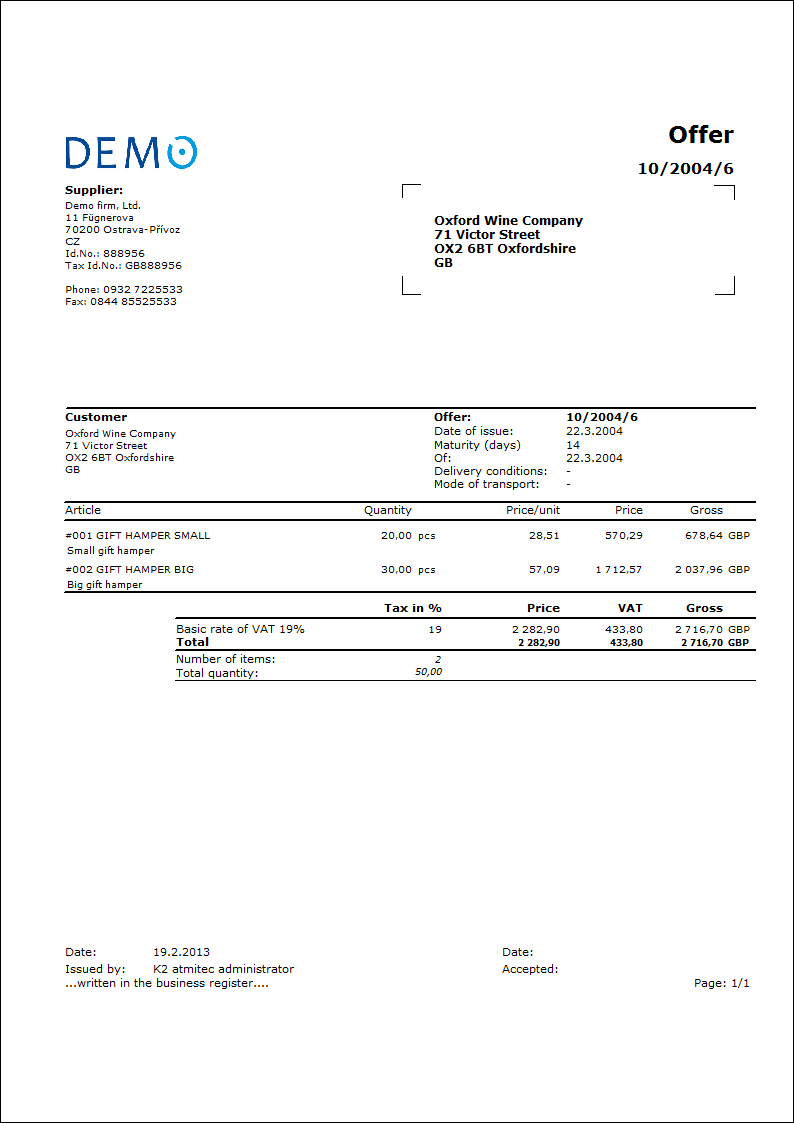
Statement of Sales Order
Process No.: ZAK014 |
Iden. Report no.: SZAK005 |
File: ZAK_VYP01='AM' |
Report description: Statement of Sales Order |
||
Address in the tree: [Sale / Processing of Sales Orders] [Sales Orders] [Print documents - Lists] |
||
Report parameters:
SupressSum - No Yes - hides the total for items. |
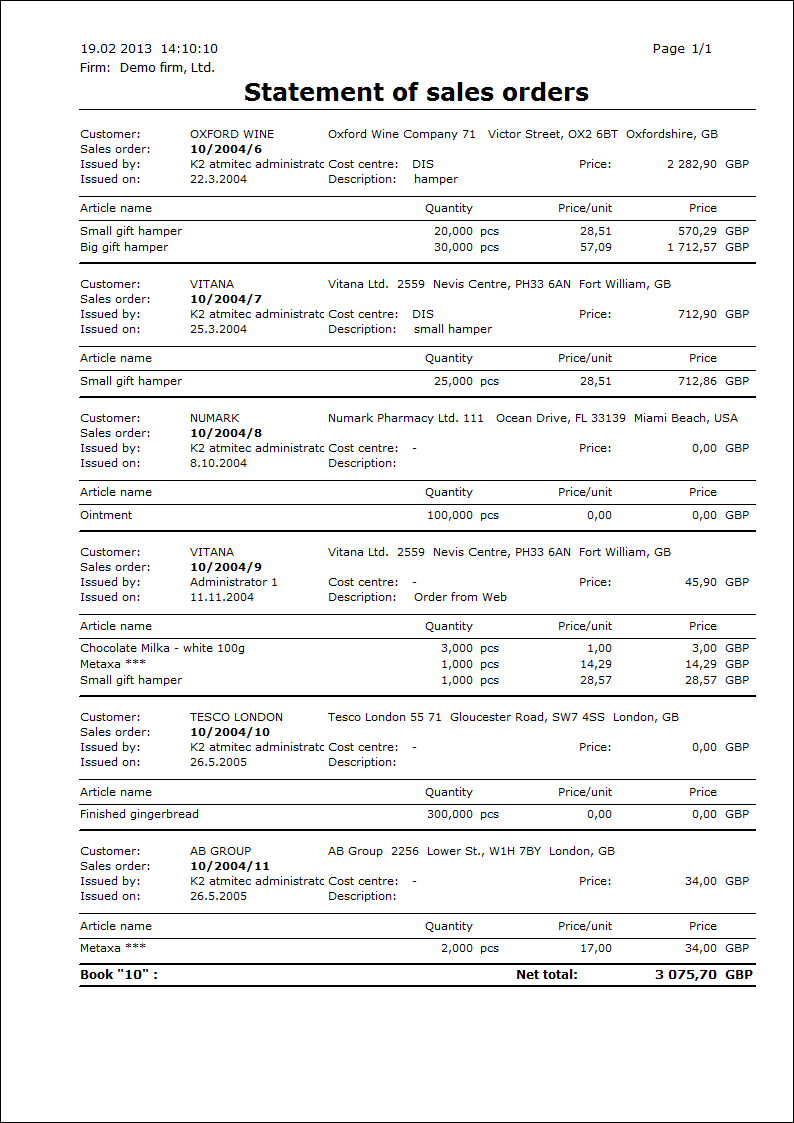
List of Sales Orders
Process No.: ZAK014 |
Iden. Report no.: SZAK003 |
File: ZAK_SEZ01='AM' |
Report description: List of Sales Orders. |
||
Address in the tree: [Sale / Processing of Sales Orders] [Sales Orders] [Print documents - Lists] |
||
Report parameters:
ShowDocDescription - No Yes - displays document description. |
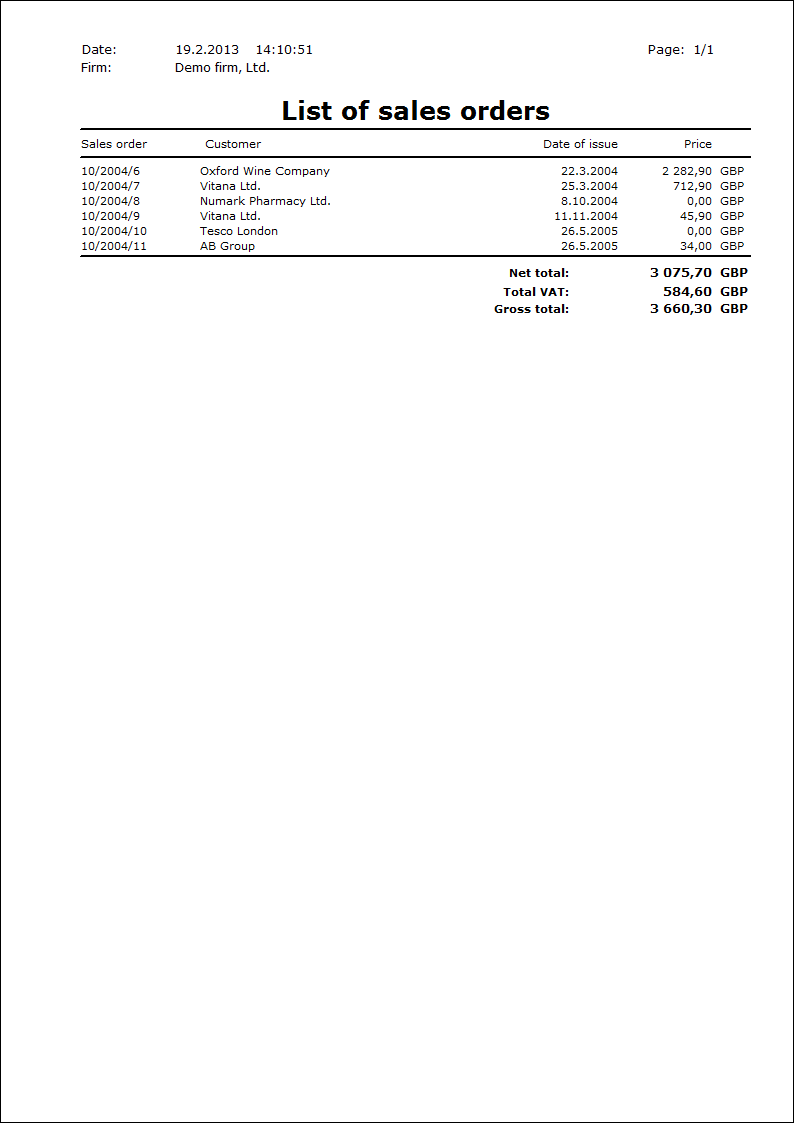
 next to the Method of transport field is mainly related to eshop. If there is an article where the
next to the Method of transport field is mainly related to eshop. If there is an article where the